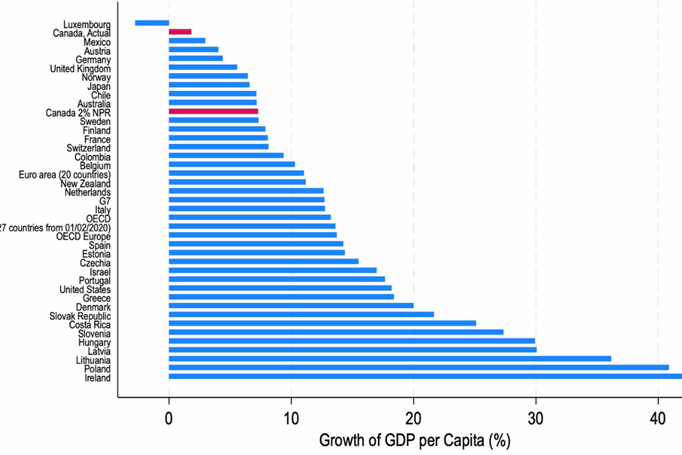TORONTO, Apr. 19, 2024 – Social Capital Partners welcomes the federal government’s decision to explore options to unlock the potential of employee ownership trusts (EOTs) as part of Canada’s economic recovery. This is a first step toward making broad-based employee ownership a more significant part of our economy. Social Capital Partners produced Building an Employee Ownership Economy in October 2020, a report calling for the establishment of EOTs in Canada, as a way to grow Canada’s comparatively low levels of employee ownership.
“There is a large body of research from around the world that points to employee ownership trusts as a powerful tool to reduce wealth inequality, support business succession, protect local jobs, and promote economic resilience,” says Jon Shell, managing partner of Social Capital Partners. “It’s great to see the government recognize that employee ownership could be part of rebuilding a more inclusive, more resilient economy.”
In the US and the UK, employee-owned companies grow faster, pay better, are less prone to lay-offs or bankruptcies in economic downturns, and are more likely to keep jobs in local economies. Due to public policy that encourages their use, EOTs are a popular structure for business succession in those countries, where they have generated significant wealth for front-line employees. EOTs are common in the US, where 14 million employees own $1.4 trillion in shares at over 6,000 companies. Since their introduction in the UK in 2014, they have become increasingly popular, with almost 100 companies becoming employee-owned in 2019 alone. Canada does not have a business structure comparable to the employee ownership trust.
“There is a large body of research from around the world that points to employee ownership trusts as a powerful tool to reduce wealth inequality, support business succession, protect local jobs and promote economic resilience.”
A recent survey by the Canadian Federation of Independent Business (CFIB) suggests significant interest among Canadian business owners in employee ownership. Fifty-nine percent of respondents were either strongly or somewhat in favour of introducing policies similar to the US and UK, and 53% said they were more likely to sell to their employees if such a policy were introduced.
“Canadian business owners are very community-oriented. We think employee ownership in Canada can be even more successful than the US and UK with the right policies in place,” said Shell. “That would mean more Canadian companies staying Canadian-owned.”
Canada’s current regulatory environment makes selling to employees very difficult. “As a business owner who believes in the power of employee ownership, I’m really excited to see it in the budget. It’s been very difficult, and taken a very long time, for me to sell some of my company to my employees. It should be a lot easier,” said Peter Deitz, Co-Founder and Board Chair of Grantbook. His comments echo those of Geoff Smith, CEO of EllisDon, one of Canada’s largest employee-owned companies, in a video he posted this past month encouraging the government to implement employee ownership trusts.
“Given the benefits, a made-in Canada approach to broad-based employee ownership should be a priority for policymakers that are looking to strengthen Canada’s economic recovery and increase the well-being of Canadians over the long-term,” says Shell.
Share with a friend
Related reading
Blame the denominator, not the economy
Over the last couple of years, there have been countless articles warning of Canada’s poor economic performance. The mic drop has increasingly been Canada’s poor performance relative to peer countries on “GDP per capita,” with growth rankings used to draw a variety of sweeping, negative conclusions about Canada’s economy. SCP CEO Matthew Mendelsohn and Policy Director Dan Skilleter draw on economist and SCP Fellow Dr. Gillian Petit's new research to explain why GDP per capita is a deeply flawed measurement for evaluating rich countries - and is easily influenced by a variety of factors having little to do with economic performance or economic well-being.
Non-Permanent Residents and their impact on GDP per capita | Summary
New research by economist and SCP Fellow Gillian Petit estimates what Canada’s GDP per capita would have been over the past decade if Canada had kept our temporary resident numbers stable. She also estimates the expected impact on GDP per capita in the coming years due strictly to planned reductions in Canada's intake of non-permanent residents. Among key findings: Canada’s GDP per capita is misleading and should not be used as if it were the sole indicator of economic well-being. Plus, if we had maintained our temporary resident numbers at two percent of the population in recent years, Canada’s GDP per capita would look much more like our peer countries: a little bit ahead of countries like Germany, the United Kingdom and Australia and a little bit lower than countries like Belgium, Sweden and France.
Non-Permanent Residents and their impact on GDP per capita | Report
New research by economist and SCP Fellow Gillian Petit estimates what Canada’s GDP per capita would have been over the past decade if Canada had kept our temporary resident numbers stable. She also estimates the expected impact on GDP per capita in the coming years due strictly to planned reductions in Canada's intake of non-permanent residents. Among key findings: Canada’s GDP per capita is misleading and should not be used as if it were the sole indicator of economic well-being. Plus, if we had maintained our temporary resident numbers at two percent of the population in recent years, Canada’s GDP per capita would look much more like our peer countries: a little bit ahead of countries like Germany, the United Kingdom and Australia and a little bit lower than countries like Belgium, Sweden and France.

